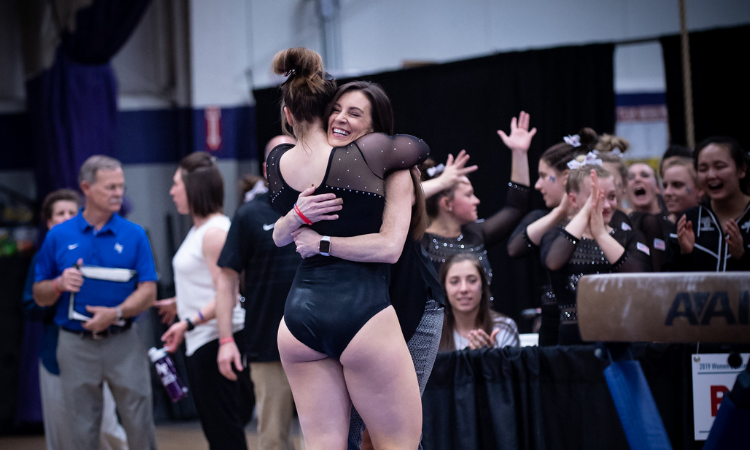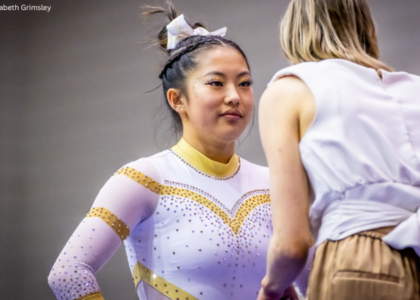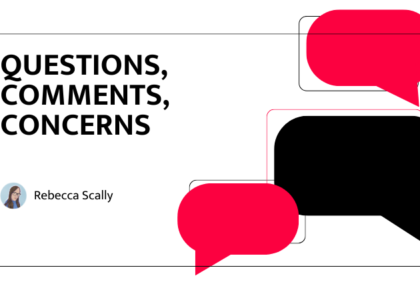Imagine you’re an athlete. Imagine you’re an athlete that’s trained in a sport for a decade and a half of your life. But then life happens, be it injury, a worldwide stoppage of time or a need to step away for a brief pause. But you can’t. You can’t pause training, can’t hold your place, you have to keep going. For those in some Division I programs, this is a stark reality. A year dangles before you. No pressure to make that next decision, right?
A redshirt year, or redshirting, is a delay or deferment of an athlete’s season for whatever reason, be it injury, academic or other extraneous situations. Most often in college gymnastics, a redshirt year is taken due to injury, although the gymnast cannot have participated in more than 30% of their season prior to the midpoint in order for them to be eligible and opt for a redshirt year. Outside of this scope, a gymnast could possibly be awarded a sixth-year of eligibility, although this is quite uncommon. This isn’t a recent development in college athletics. The University of Nebraska lays claim to the first redshirt in history when football player Warren Alfson wanted time to get into better shape for the football team and asked for a year off to do so, wanting to continue attending practice but not play.
For a majority of Division I and II college athletes, this means student-athletes have 10 semesters, or 15 quarters, in which to complete their degree or enrollment. Within those semesters or quarters, which could be up to five years, they have four years or seasons of competitive eligibility. This means there’s no need to take time away, opt for a gap year or even unenroll from school, allowing them the time they need to focus on healing or recuperating, not pushing to return to their sport too soon, both physically or mentally.
What does this mean for other divisions? For gymnasts that are in Division III and Ivy League colleges, there is no option to take that redshirt year. A bit strange, no? Especially when you consider there is lifelong health on the line, in addition to all those years of training gymnastics with the hopes of one day competing in college. An injury or pandemic can certainly upend those plans in the blink of an eye.
For those who want to keep going, the path isn’t easy. For Brown University gymnasts Alyssa Gardner and Lauren McKeown, the choice to take a gap year, since a redshirt year wasn’t available to them as part of an Ivy League college, was a way for them to take control of their remaining time with gymnastics.
The decision for both didn’t come lightly or easily. Within the Ivy League, there is zero redshirting. You must complete your time within four seasons. If an athlete or gymnast wants to extend their time with the program, they must leave the school for those term lengths. For Gardner and McKeown, that’s exactly what they did.
As COVID-19 surged through the country, seasons were canceled in the spring of 2020 and again canceled the following year for several programs, including Brown’s. For the pair, this meant a year of no gymnastics. For Gardner, it meant even more uncertainty of if or when there would be another chance for her to compete before graduating college as the world was changing each and every week.
For both Gardner and McKeown, they didn’t want to see their remaining time with gymnastics gone without their say. Gardner “wanted to end gymnastics on her terms, [not because] of a decision from the Ivy League.” She had wanted to be a competitive gymnast since she was just seven years old, so stepping back to end things on her terms was important to her. McKeown felt similarly, and with “no indication that they’d be able to train,” she, too, was prepared to step away for a year.
As the 2020 season came to a halt and the academic year was winding down, Gardner and McKeown both started a dialogue with Brown head coach Sara Carver-Milne. For Carver-Milne, she wanted what was best for each gymnast. She told them, “You’ve got to do what makes you happiest,” and to consider a few things before making that decision, including “how important is gymnastics, how important is graduating on time [and] could they study remotely and be successful.” The answers were clear to both.
However, once the decision was made, Gardner and McKeown were back to square one when it came to contact. Carver-Milne couldn’t reach out to her former and future gymnasts. This meant she couldn’t provide any guidance, including training plans or workouts, and she couldn’t even receive videos to supply feedback. Any and all contact had to be driven by the gymnasts. For Gardner, this meant training in her old gym but with a twist. Instead of training the same hours, she swapped to a training plan that was “smart gymnastics [with] smart volume.” McKeown followed suit, training fewer hours, as there was no reason for either to risk injury.
It’s hard to imagine a college putting a wall between coach and athlete when the athlete is still in pursuit of fulfilling their dream. Such is the case, however, for so many programs that have intricate and tricky rules to navigate. So many Division I athletes still have the same resources at their fingertips during redshirt years, and it feels unnecessary to expect athletes to look out for their well-being without that familiar support system. After all was said and done, though, the gap year paid off. Brown went on to smash several program records at the recent GEC championship, made all the more special as it was the host team. For Gardner and McKeown, their gap years meant they can write their names in the history books.
READ THIS NEXT: Limited Leotard Budgets for Division III Programs Force Creative Thinking
Article by Allison Freeman
Like what you see? Consider donating to support our efforts throughout the year!




